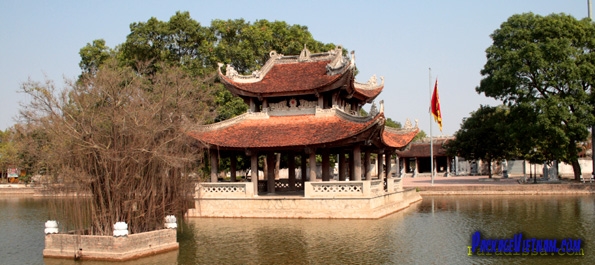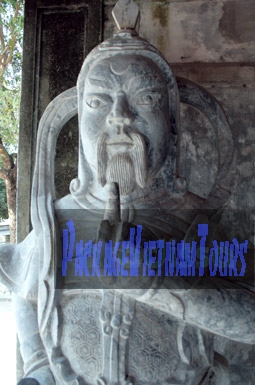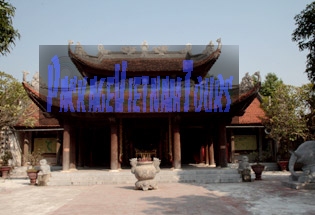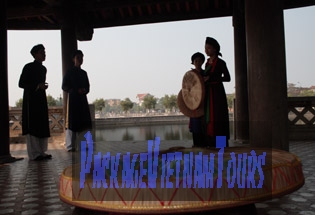
Do Temple - Bac Ninh
Related Links
The Ly Dysnasty was started by Ly Cong Uan in 1009 and it helped to bring Vietnam into a new era, the era of independence and prosperity. Ly Cong Uan was also a visionary king that built Thang Long (or
Ha Noi) today into the capital city of
Vietnam in 1010.
Ly family was the founder of the Temple of Literature and the first national school of Vietnam starting a new tradition in the Vietnamese culture, the tradition of learning and respecting knowledge.
Den Do (Do Temple) in the
northern province of Bac Ninh was built under the Ly Dynasty in 1030 southeast of Co Phap Village, or Dinh Bang Village today, in Tu Son District. This was where Ly Cong Uan was born.

Thuy Dinh of Den Do (Do Temple) where water puppet was performed in the past. Nowadays, it's for Quan Ho Folk Song performances.
After ascending to the throne in 1010, Ly Thai To took a dragon boat trip on the poetic Tieu Tuong River to his homeland to visit the elderly people there and offerred incense at his mother’s tomb. He also measured out an area covering dozens of miles to set up Son Lang Cam Dia (forbidden mausoleum area), which was the complex of the Ly family's tombs. After Ly Thai To died in 1028, his son Ly Thai Tong succeeded the throne and built Do Temple at Son Lang Cam Dia to worship his father. Since then the temple, also called Co Phap Dien or Ly Bat De Temple, has become the place to worship the kings after death.
The temple was repaired and upgraded many times. The biggest enlargement was in 1602. At that time, the temple complex covered 31,250 square meters and housed 21 differently buildings.
In 1952, the temple was destroyed in the war against the French. In 1989, it was restored with its original architecture of the 17th century.
There are successive lakes and ponds running through Dinh Bang Village which are what used to be known as the Tieu Tuong River.
In the middle of the lake in front of Do Temple is a two-story eight-roofed house floating on the water as a stage where water-puppetry is performed. The Thuy Dinh floating stage was restored in 2000 after it was destroyed in the war.
Touring the Do Temple, you'll walk on a road paved with Bat Trang tiles, you reach the large outer yard and then pass through Ngu Long Mon (five-dragon gate) to the inner yard. Then comes the two-story Chuyen Bong House, whose roofs are shaped like spear heads. Behind Chuyen Bong is Hau Cung, which houses the statues of the eight Ly kings. They are Ly Thai To (1009-1028), Ly Thai Tong (1028-1054), Ly Thanh Tong (1054-1072), Ly Nhan Tong (1072-1128), Ly Than Tong (1128-1138), Ly Anh Tong (1138-1175), Ly Cao Tong (1175-1210) and Ly Hue Tong (1210-1224).
Around one kilometer from Hau Cung is the Dragon Temple dedicated to Ly Chieu Hoang, Ly Hue Tong’s daughter who took the throne at the age of seven in November 1224.
Ly Chieu Hoang ruled only some months until January 1225, then left the throne to her husband Tran Canh, who founded the Tran Dynasty.
At the Do Temple there's an annual festival honoring tributes to the Ly Kings. The Do Temple Festival is on March 15th, lunar calendar. On this day in 1009, Ly Cong Uan took the throne becoming the king of Dai Co Viet, another name of Vietnam that time. The ceremony on that day starts with a procession of the tablet of King Ly Thai To to Ung Tam Pagoda where Ly Thai To was born.
The festival also includes Quan Ho folk songs, water puppet performances and many competitions, such as wrestling, chess, cock fighting and pigeon releasing.
Do Temple is 15km from Ha Noi along Road No.1.

Guardian of the Do Temple

Entrance to the Do Temple

Hau Cung (Chuyen Bong) where the 8 Ly Kings are worshipped

Performing Quan Ho at Do Temple
Vietnam Travel Guides
- Activities
- Arts & Entertainment
- Bac Kan
- Bac Lieu
- Bac Ninh
- Battlefields
- Ben Tre
- Buon Ma Thuot
- Ca Mau
- Can Tho
- Cao Bang
- Cat Ba Island
- Chau Doc
- Climate
- Cu Chi Tunnel
- Da Lat
- Da Nang
- Dangers & Annoyances
- Economy
- Embassies & Consulates for Vietnam
- Embassies & Consulates of Vietnam
- Festivals & Events
- Food & Drinks
- Geography
- Gia Lai




 Print
Print 




